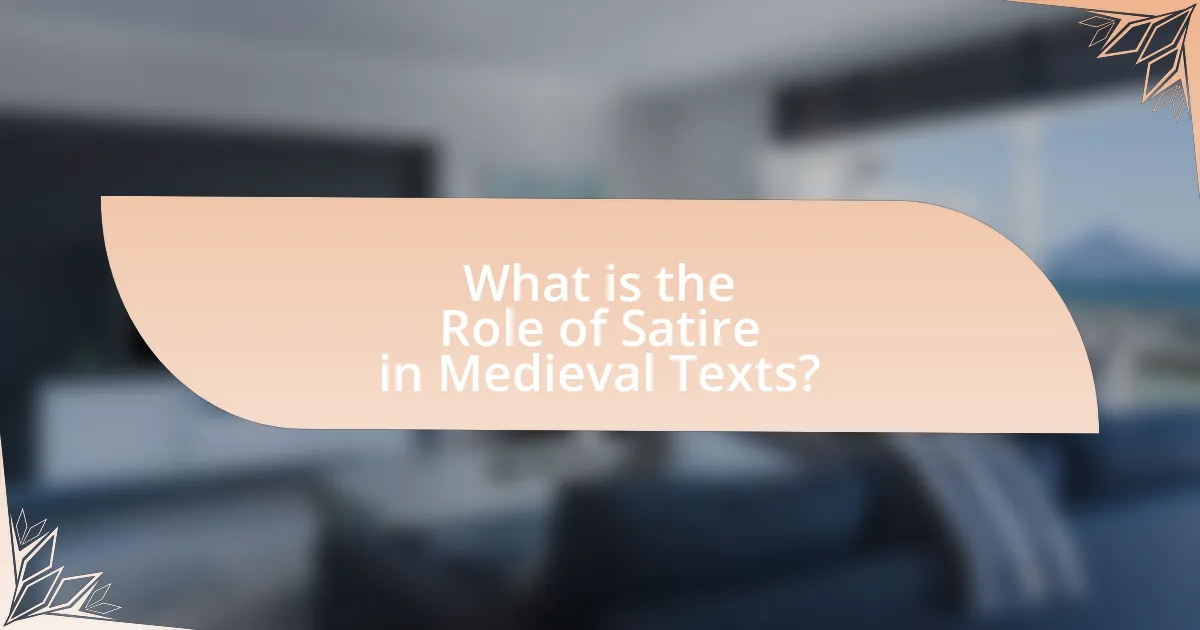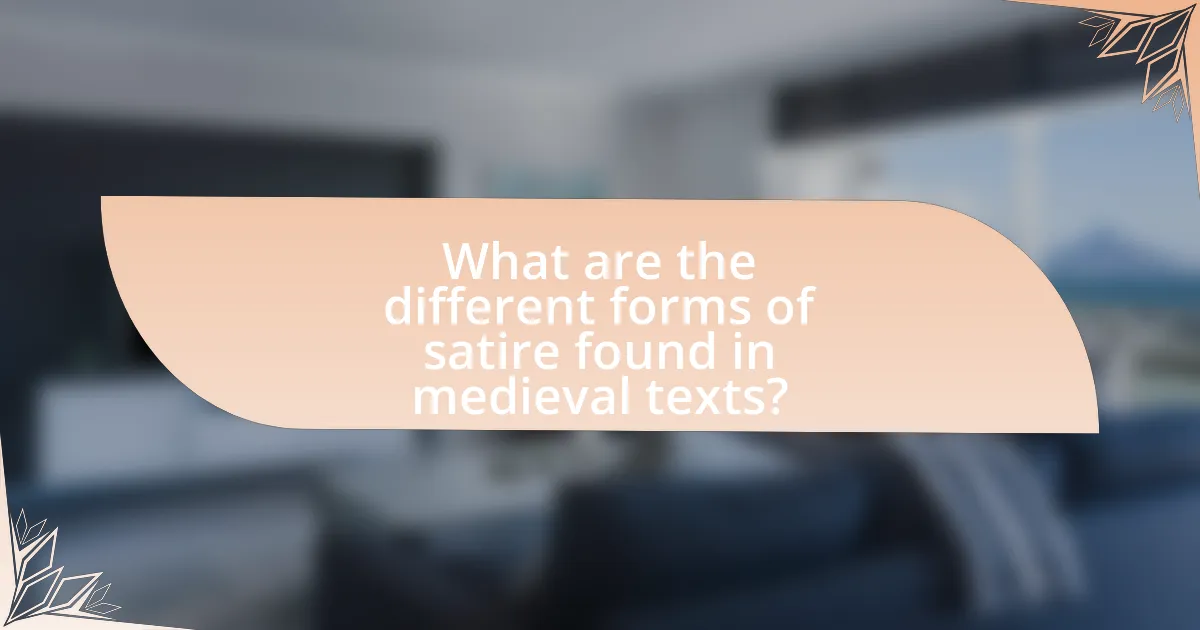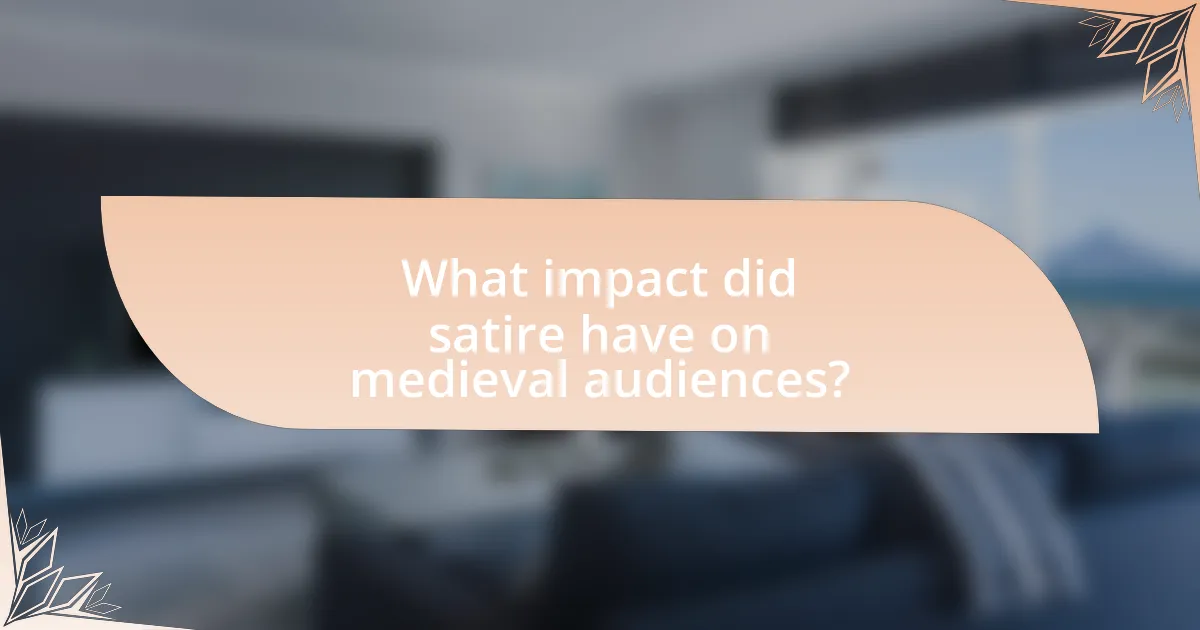The article examines the role of satire in medieval texts, highlighting its function as a critical tool for social commentary and moral reflection. It discusses how authors like Geoffrey Chaucer utilized satire to critique societal issues, challenge authority, and expose hypocrisy through humor and irony. Key characteristics of medieval satire, including humor, irony, and social criticism, are explored, along with its impact on public perception and critical thinking among audiences. The article also outlines various forms of satire, such as parody and allegory, and their significance in addressing corruption and moral failings within the Church and society.

What is the Role of Satire in Medieval Texts?
Satire in medieval texts serves as a critical tool for social commentary and moral reflection. It allows authors to address societal issues, challenge authority, and expose hypocrisy through humor and irony. For instance, works like Geoffrey Chaucer’s “The Canterbury Tales” utilize satire to critique the corruption within the Church and the flaws of various social classes. This approach not only entertains but also encourages readers to reflect on moral and ethical standards of the time, making satire a significant literary device in medieval literature.
How did satire function as a literary device in the medieval period?
Satire functioned as a literary device in the medieval period by critiquing societal norms, institutions, and human behavior through humor and irony. This form of expression allowed authors to address controversial topics, such as corruption within the Church and the flaws of the nobility, without facing direct repercussions. For example, works like Geoffrey Chaucer’s “The Canterbury Tales” employed satire to expose the hypocrisy of various social classes, using characters like the Pardoner to illustrate moral failings. Additionally, satirical texts often utilized allegory and parody, making complex social critiques accessible to a broader audience, thereby reinforcing the power of satire as a tool for social commentary during the medieval era.
What are the key characteristics of satire in medieval literature?
The key characteristics of satire in medieval literature include humor, irony, and social criticism. Medieval satirical works often employed humor to expose the follies and vices of individuals, particularly those in positions of power, such as clergy and nobility. Irony was frequently used to highlight contradictions between societal ideals and actual behaviors, effectively critiquing moral and ethical standards of the time. Additionally, social criticism in medieval satire aimed to provoke thought and encourage reform by addressing issues like corruption, hypocrisy, and social injustice, as seen in texts like Geoffrey Chaucer’s “The Canterbury Tales,” which satirizes various social classes and institutions.
How did satire reflect societal norms and values of the time?
Satire in medieval texts reflected societal norms and values by critiquing the behaviors, beliefs, and institutions of the time. For instance, works like Geoffrey Chaucer’s “The Canterbury Tales” used humor and irony to expose the hypocrisy of the church and the moral failings of various social classes, illustrating the tension between societal expectations and actual conduct. This critique served to reinforce or challenge prevailing values, as seen in the way satirical portrayals of clergy highlighted the corruption within the church, prompting audiences to reflect on moral integrity and social justice. Such texts not only entertained but also provided a mirror to society, revealing the contradictions between ideals and reality, thus shaping public discourse and influencing cultural attitudes.
Why was satire important in medieval society?
Satire was important in medieval society because it served as a tool for social critique and commentary. By using humor and irony, satirical works addressed issues such as corruption within the church and government, highlighting moral failings and societal injustices. For instance, Geoffrey Chaucer’s “The Canterbury Tales” employed satire to expose the hypocrisy of various social classes, particularly the clergy, thereby encouraging reflection and reform among readers. This function of satire not only entertained but also fostered a critical awareness of societal norms and behaviors, making it a vital component of medieval literature and culture.
How did satire serve as a tool for social critique?
Satire served as a tool for social critique by exposing societal flaws and injustices through humor and irony. Medieval satirists, such as Geoffrey Chaucer and Dante Alighieri, utilized satire to highlight corruption within the church and the moral failings of the aristocracy. For instance, Chaucer’s “The Canterbury Tales” employs comedic narratives to critique the hypocrisy of religious figures, thereby prompting readers to reflect on the moral state of society. This method of critique was effective because it engaged audiences in a manner that was both entertaining and thought-provoking, allowing for a deeper examination of social norms and behaviors.
What role did satire play in the context of political commentary?
Satire served as a critical tool for political commentary by exposing the flaws and corruption within political systems and figures. In medieval texts, authors utilized satire to challenge authority and provoke thought among the populace, often using humor and irony to convey serious messages. For instance, works like Geoffrey Chaucer’s “The Canterbury Tales” employed satirical elements to critique the Church and societal norms, reflecting the political landscape of the time. This method not only entertained but also encouraged readers to question the status quo, making satire an essential component of political discourse in medieval literature.

What are the different forms of satire found in medieval texts?
Different forms of satire found in medieval texts include parody, invective, and allegory. Parody mimics and exaggerates the style of other works, often to critique societal norms or literary conventions, as seen in works like “The Canterbury Tales” by Geoffrey Chaucer. Invective employs harsh, scornful language to attack individuals or institutions, exemplified in the writings of authors like John of Salisbury. Allegory uses symbolic figures and actions to convey moral lessons, with texts such as “Piers Plowman” by William Langland illustrating social and religious critiques through allegorical narratives. These forms collectively highlight the complexities of medieval society and its values.
What types of satire were prevalent in medieval literature?
In medieval literature, prevalent types of satire included social satire, political satire, and religious satire. Social satire critiqued societal norms and behaviors, often highlighting the flaws and vices of various social classes, as seen in works like Geoffrey Chaucer’s “The Canterbury Tales.” Political satire targeted the corruption and incompetence of rulers and officials, exemplified in texts such as “Piers Plowman” by William Langland. Religious satire criticized the practices and hypocrisy within the Church, notably in works like “The Golden Legend” by Jacobus de Voragine, which exposed the moral failings of clergy. These forms of satire served to reflect and challenge the prevailing attitudes of the time, using humor and irony to provoke thought and encourage reform.
How did parody differ from other forms of satire in this period?
Parody in this period primarily differed from other forms of satire by focusing on imitation and exaggeration of specific works or styles, often for comedic effect. While general satire aimed to critique societal norms or political issues through broader commentary, parody specifically targeted the form and content of particular texts or genres, highlighting their absurdities. For instance, medieval parodies often mimicked religious texts or chivalric romances, using humor to expose their flaws or contradictions, which was distinct from the more serious tone of other satirical works that sought to provoke thought or inspire change. This distinction is evident in works like “The Canterbury Tales,” where Chaucer employed parody to mock the pretensions of various characters, contrasting with the more direct moral critiques found in other satirical literature of the time.
What examples illustrate the use of allegory in medieval satire?
Examples that illustrate the use of allegory in medieval satire include “The Divine Comedy” by Dante Alighieri and “The Canterbury Tales” by Geoffrey Chaucer. In “The Divine Comedy,” Dante employs allegory to depict the journey of the soul towards God, using characters and settings to represent moral and spiritual lessons. Similarly, Chaucer’s “The Canterbury Tales” features various characters that symbolize different societal roles and vices, critiquing the moral failings of the time. Both works serve as vehicles for social commentary, using allegorical elements to convey deeper meanings about human nature and society.
How did various authors employ satire in their works?
Various authors employed satire in their works to critique societal norms, politics, and human behavior. For instance, Geoffrey Chaucer utilized satire in “The Canterbury Tales” to expose the hypocrisy of the Church and the moral failings of its representatives, such as the Pardoner and the Friar. Similarly, Jonathan Swift’s “A Modest Proposal” employed biting satire to highlight the dire economic conditions in Ireland, suggesting absurd solutions to provoke outrage and reflection among readers. Additionally, authors like Dante Alighieri in “The Divine Comedy” used satire to comment on the corruption of political and religious figures in his contemporary society. These examples illustrate how satire served as a powerful tool for social commentary and critique in medieval literature.
What techniques did Chaucer use to convey satire in “The Canterbury Tales”?
Chaucer employed various techniques to convey satire in “The Canterbury Tales,” including characterization, irony, and social commentary. Characterization allows Chaucer to create vivid, exaggerated portraits of different social classes, such as the corrupt Pardoner and the hypocritical Friar, highlighting their flaws and societal roles. Irony is prevalent throughout the tales, as characters often say one thing while their actions reveal the opposite, exposing the contradictions in societal norms and behaviors. Additionally, Chaucer’s social commentary critiques the Church and the aristocracy, reflecting the moral decay of his time. These techniques collectively serve to illuminate the absurdities and vices of society, making his satire both impactful and enduring.
How did Dante’s “Divine Comedy” utilize satire to critique society?
Dante’s “Divine Comedy” utilized satire to critique society by exposing the moral and political corruption of his time through allegorical representations of sin and punishment. The text employs vivid imagery and ironic contrasts to highlight the failings of individuals and institutions, such as the Church and political leaders, thereby encouraging readers to reflect on their own moral choices. For instance, Dante places corrupt popes in Hell, illustrating the hypocrisy of religious authority, which serves as a direct commentary on the state of the Church during the 14th century. This satirical approach not only entertains but also provokes critical thought about societal values and ethics, making it a powerful tool for social critique.

What impact did satire have on medieval audiences?
Satire significantly influenced medieval audiences by providing a means to critique societal norms and authority figures. Through humor and irony, satirical works exposed the hypocrisy of the church and the nobility, prompting reflection and discussion among the populace. For instance, texts like Geoffrey Chaucer’s “The Canterbury Tales” utilized satire to highlight moral failings and social injustices, engaging audiences in a dialogue about ethics and governance. This engagement often led to increased awareness and, in some cases, social change, as audiences began to question established power structures.
How did satire influence public perception and opinion in the medieval era?
Satire significantly influenced public perception and opinion in the medieval era by providing a critical lens through which societal norms, politics, and religious practices were examined. This genre of literature often employed humor and irony to challenge authority figures and highlight societal flaws, making complex ideas accessible to a broader audience. For instance, works like Geoffrey Chaucer’s “The Canterbury Tales” used satire to critique the corruption within the Church and the hypocrisy of various social classes, thereby shaping public discourse and encouraging critical thinking among readers. Additionally, satirical texts circulated widely, often in oral form, which allowed them to reach illiterate populations, further amplifying their impact on public opinion and fostering a culture of questioning established norms.
What reactions did satirical works provoke among different social classes?
Satirical works provoked varied reactions among different social classes, often reflecting their social status and perspectives. The upper classes typically responded with defensiveness or disdain, viewing satire as a threat to their authority and social order, while the lower classes often embraced satire as a means of expressing dissent and critiquing the status quo. For instance, works like Geoffrey Chaucer’s “The Canterbury Tales” highlighted the hypocrisy of the clergy, resonating with commoners who felt marginalized by the church’s corruption. This dynamic illustrates how satire served as both a mirror and a weapon, enabling the lower classes to voice their grievances while prompting the elite to confront uncomfortable truths about their own behavior.
How did satire contribute to the development of critical thinking in medieval readers?
Satire contributed to the development of critical thinking in medieval readers by challenging societal norms and encouraging skepticism towards authority. Through the use of humor and irony, satirical works prompted readers to question the validity of established beliefs and practices, fostering an environment of inquiry. For instance, texts like Geoffrey Chaucer’s “The Canterbury Tales” employed satire to critique the Church and social classes, which encouraged readers to reflect on moral and ethical issues. This engagement with satire not only entertained but also stimulated intellectual discourse, leading to a more questioning and analytical mindset among medieval audiences.
What lessons can modern readers learn from medieval satire?
Modern readers can learn the importance of social critique and the use of humor as a tool for reflection from medieval satire. Medieval satirical works, such as those by Geoffrey Chaucer and Dante Alighieri, often highlighted societal flaws, hypocrisy, and moral failings, encouraging readers to question authority and societal norms. For instance, Chaucer’s “The Canterbury Tales” employs satire to expose the corruption within the Church and the shortcomings of various social classes, demonstrating how humor can effectively convey serious messages about morality and ethics. This historical context illustrates that satire serves not only as entertainment but also as a means of prompting critical thought and fostering social change.
How can contemporary society benefit from understanding medieval satire?
Contemporary society can benefit from understanding medieval satire by gaining insights into social critique and the use of humor as a tool for addressing power dynamics. Medieval satire often highlighted societal flaws, corruption, and injustices, which can inform modern discussions about governance, ethics, and social responsibility. For instance, works like Geoffrey Chaucer’s “The Canterbury Tales” employed satire to critique the Church and social classes, revealing enduring themes of hypocrisy and moral failings that resonate today. By analyzing these texts, contemporary audiences can better understand the historical context of satire and its relevance in fostering critical thinking about current societal issues.
What are some best practices for analyzing satire in historical texts?
Best practices for analyzing satire in historical texts include understanding the historical context, identifying the target of the satire, and examining the use of literary devices. Historical context is crucial as it provides insight into the societal norms and issues that the satire addresses, such as political corruption or social injustice prevalent during the medieval period. Identifying the target of the satire helps clarify the author’s intent and the specific audience they aimed to influence, which can often be political figures or societal groups. Additionally, examining literary devices such as irony, exaggeration, and parody reveals how the author constructs their critique, enhancing the understanding of the text’s impact and significance. These practices ensure a comprehensive analysis that respects the nuances of satire within its historical framework.